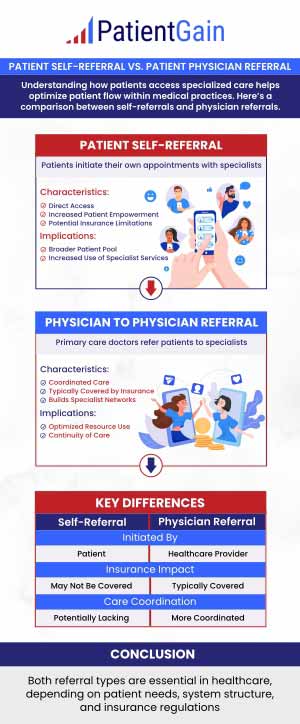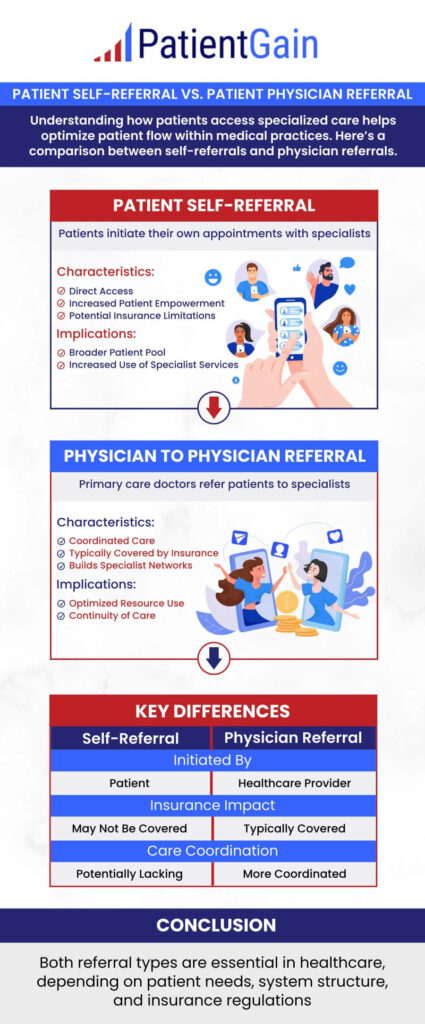Understanding Patient Flow: Patient Self-Referral vs. Patient Physician Referral
Optimizing patient flow within a medical practice requires understanding how patients reach your doors. This involves recognizing the key differences between patient self-referral and physician-to-physician referral.


Patient Self-Referral: Taking Charge of Healthcare
- Definition: Patients take the initiative to seek specialized care without a recommendation from another healthcare provider. This might be based on their research, symptoms, or personal preferences.
- Characteristics:
- Direct Access: Patients can schedule appointments with specialists directly, empowering them to manage their healthcare.
- Empowerment: This approach fosters patient engagement and satisfaction with their healthcare decisions.
- Insurance Considerations: Depending on the system and insurance, self-referrals may not be covered, impacting patient choice.
- Implications:
- Wider Patient Pool: Specialists can see a broader range of patients beyond those referred by other doctors.
- Increased Service Use: Patients might utilize specialists more frequently without prior evaluation by a PCP.
Physician-to-Physician Referral: A Coordinated Approach
- Definition: A primary care doctor (PCP) or general practitioner refers a patient to a specialist for further examination, treatment, or expert care.
- Characteristics:
- Coordinated Care: Ensures specialists receive background information and medical history from the PCP, facilitating a coordinated approach.
- Insurance Approval: In many systems, referrals are necessary for insurance coverage of specialized services.
- Specialist Network: Referrals build networks and reciprocal relationships within the medical community.
- Implications:
- Standard of Care: Pre-screening by the PCP can optimize resource use and potentially improve patient outcomes.
- Continuity of Care: Information is typically exchanged between referring and receiving doctors, promoting integrated care.
Key Differences at a Glance:
| Feature | Patient Self-Referral | Physician-to-Physician Referral |
| Initiated by | Patient (82% patients look for you on Google) | Healthcare provider (PCP/doctor) |
| Insurance Impact | May not be covered | Typically covered |
| Care Coordination | Potentially lacking | More coordinated care |
| Network Dependence | Not a factor | Relies on professional networks |
The Right Choice for the Right Patient
Both self-referral and physician referral play a role in modern healthcare. The best option depends on:
- Patient Needs: The specific healthcare issue and whether a specialist is truly necessary.
- Healthcare System Structure: How referrals are handled within the healthcare system.
- Insurance Regulations: Whether insurance covers self-referrals or requires a doctor’s referral.
By understanding these distinctions, medical practices can optimize patient flow and ensure patients receive the most appropriate care based on their needs.
While we do live in a world that mixes digital marketing with traditional marketing, many new doctors make the mistake of neglecting an valuable source for new customers to their clinic: Patient Referrals. While it does take some effort to get a system up and running, it is very cost-effective and often provides excellent leads for new patients. Best of all, unlike traditional marketing, you are not advertising to a large pool of people hoping to get a few interested in your services. Generally, the people who come to your clinic for patient referrals are people who are specifically looking for your services.
Question 1: Should I wait for patient referrals to arrive?
Patient referrals require some proactive actions from your clinic. It isn’t putting up a billboard and hoping you connect with the right person randomly on the street. For your patient referral program to get off the ground, you need to solicit them from your current patient base. It can be awkward to ask for these referrals, and at first, you may feel like you are pushing too much or you are too “Sale-sy.” However, with some planning and structure, it will become easier and more comfortable for you and your staff to solicit patient referrals.
Question 2: Am I already getting patient referrals? What does a patient referral program look like?
When you boil it down, a patient referral program is an organized effort to get your current, loyal patients to recommend your services to someone. Generally, the patients who do send referrals your way are among your most loyal customers and perhaps are “brand advocates” to your medical practice. Organized patient referral programs may have some incentives associated with them in terms of gift cards, discounts, or even swag from your clinic. You should check with local laws and regulations to make sure the incentives of your patient referral program are legal where your clinic is located.
Question 3: What are some key parts of a patient referral program?
No 1. Create specific materials for your patient referral program.
For your program to be successful, you should create, and print materials designed explicitly for patient referrals. You will want printed materials to give to patients, so they have something to give to others when they refer them to your practice. These brochures should have a summary of the services you offer, a contact number, your location, and (if possible) a special offer for new patients. Some medical clinics even have small “thank-you” gifts to send to patients who successfully refer someone to your practice.
It is crucial not to make a half-hearted attempt at this and be inconsistent with your program. Be sure to consistently recognize new patients and those who refer them to your practice. Failing to do so will make it hard for your patient referral program to gain traction.
No 2. Advertise that you are accepting new patients and you welcome referrals
How are patients supposed to know you welcome their referrals if you don’t tell them? Create signage and materials explaining that your practice welcome patient referrals and the incentives you offer if someone is referred to your office. Some medical clinics incorporate a small message on their bills, indicating they accept referrals and to encourage patients to send new prospective patients to your medical clinic. Depending on the nature of your medical practice, it may be even useful to include small care or information every time you send paperwork or a medical report home with a patient.
No 3. Be mindful of various regulations and codes of ethics when you determine incentives.
Unfortunately, there is no nationwide standard when it comes to what kind of incentives you can give to patients who refer others to your medical practice. Generally, discounting services are acceptable in all areas. When possible, medical clinics also offer gift cards, enter names into monthly drawings, or give coupons for specific amounts off of certain services. If you are unsure whether or not you can legally offer an incentive, check with your local medical association for guidance. They may have some additional resources or can put you in touch with another doctor with a system in place for you to ask questions.
No 4. Assign an employee to manage your patient referral program.
A patient may be happy to refer you to other people, but they are not going to want to hear it throughout every step of their visit to your medical clinic. It will quickly become obnoxious, and you will not see the results you want. Pick a point in a patient’s journey during their appointment with you to gently remind them about your patient referral program. Often, this is done as they arrive or as they leave your practice. For those who do not send informational material home after every visit, this could be an opportunity for a staff member to mention your referral program and the benefits associated with it. Monitor the results and feel free to experiment with different touch points during a patient’s visit to your clinic to find the moment that produces the most significant results.
No 5. Be consistent with your approach when requesting referrals.
In order for you to evaluate the results of your patient referral program, be consistent with how you are requesting them. If you have multiple doctors at your medical practice and different sets of staff working throughout the week, make sure everyone is on the same page with your program. You will not have reliable data if some doctors are handing out business cards, other brochures, and others doing both. Everyone working for you should be doing the same thing so you can evaluate this program. If part of your requesting process involves text messages or emails, it would be beneficial if you had an automatic program send these out. First, you will be less likely to miss someone. Second, many of these services provide reporting letting you know how often emails are opened, and text messages are responded to.
When a new doctor or employee starts working for you, review with them your patient referral program, and check-in with them often during their first few months at your medical practice. They may think they have it committed to memory, but they may be skirting a few steps that overall make your efforts less effective. Periodically review the program with others to eliminate any bad habits.
No 6. Evaluate the effectiveness of your patient referral methods, but also give it time to develop
You shouldn’t expect immediate results from your patient referral program. It takes time for it to develop, and it may even take some time for all of your current patients to realize you have a program. Give it time to develop before you do a serious evaluation of your efforts. If changes are made, give those changes time to take effect. Avoid changing aspects of your patient referral program frequently. It adds confusion to not only staff but also your patients. If you are changing aspects and the process of your patient referral program every month, you are only setting yourself up for failure. With that said, don’t cling to a failing process because it’s easier than making changes.
Where do patients look?
Patients look for your services on:
1) Google SEO (Learn more about how healthcare SEO works)
2) Google local SEO (Learn more about how local SEO works)
3) Google Ads (Learn more about how Google ads work)
4) Facebook, Instagram, YouTube, TikTok Ads (Learn more about social media advertising)
5) Digital ads on other secondary websites (Insurance websites, healthgrades, vitals, and other medical and dental directories etc)
6) Offline traditional advertising (Newspapers, TV, Yellow pages, billboards, leaflets, flyers, USPS mailed attention grabbers)
7) Referrals and relationship marketing (Referrals from your network of other providers, building local relationships, referral events, local presence events)
8) Influencer marketing (Using social media influencer personalities endorsing your services, another form is other patients posting good experience with your practice, A.K.A Google Reviews)
9) Word of mouth (Existing happy patients tell their family members, friends and neighbors)
10) Ecommerce apps (Like Amazon, etc)
How can PatientGain help you?
New patient acquisition platform & marketing service costs $799 to $1399/mon. No upfront costs, best customer service in the industry and easy start. Hundreds of healthcare practices, and thousands of providers, use PatientGain in US and Canada.
The GOLD service from PatientGain is used by telemedicine physicians, dentists, surgeons, pediatrics, medical spas, pain management, functional medicine, primary & urgent care, cardiologists, podiatrists, addiction medicine, regenerative, wellness, therapy, OBGYN, integrative medicine, dentists, dermatologists, IVF & reproductive, pharma, bio-tech & many other medical practices.
